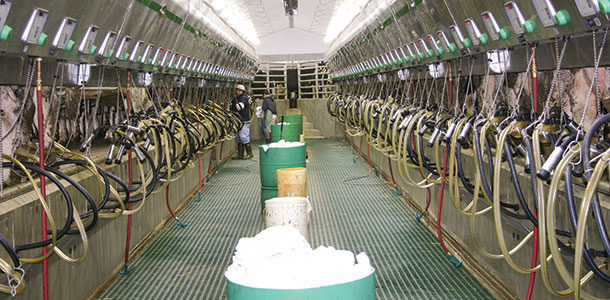Milking routines include milking procedures such as pre-dipping, forestripping and drying of the teats along with timing of milking unit attachment. The timing between these events is important if dairy operators want to maintain or improve milk quality and maximize cow throughput in their milking centers.
Milking routines are not about which procedures you include or don’t include but more about the sequence and timing of included events. Historically, milking units have been attached 60 seconds after the start of stimulation, which usually is forestripping.
It is important to define prep-lag time and lag time. Prep-lag time is the time from first interaction with the cow until the milking unit is attached. The start of prep-lag time could be pre-dipping, forestripping, dry wiping, etc.
Lag time is the time from first tactile interaction, or the start of stimulation, to milking unit attachment. The start of lag time could be forestripping or drying, but not pre-dipping as it is not a form of stimulation. Achieving a proper lag time of 90 to 120 seconds for cows milked three times daily will improve milking center efficiency.
We know that cows in late lactation have a higher incidence of bimodal milk curves, which is believed to occur because of lower flow rates or lower mammary pressure. A bimodal milk curve is a milk flow curve that peaks and then drops back to no or low flow, and then flow begins a second time.
The initial peak in flow represents the cisternal milk, or the 20 percent of milk that is available at the start of milking. Approximately 80 percent of milk requires the presence of oxytocin in order to expel the milk into the duct work of the mammary gland, allowing the milk to travel to the teat for harvest.
It is well documented that cows in later lactation, given a longer lag time, have less bimodal milk curves and shorter milking unit on-time.
Knowing that late-lactation cows have an increased incidence of bimodal milk curves led a group of researchers at Cornell University to look at cows milked three times daily who have lower flow rates than cows milked twice daily and determine if the old lag time of 60 seconds was adequate.
During two different research projects, we looked at the impact of lag times from zero to 240 seconds on milking unit on-time, average milk flow, bimodal milk curves, milk in the first two minutes and time spent in low flow.
In the second study, we looked at manual versus mechanical stimulation. Mechanical stimulation was either normal pulsation at time of attachment or a high-vibration, low-vacuum pulsation (300 pulsation cycles at 4”Hg) at the time of milking unit attachment.
In the first study, 786 cows were enrolled from a 1,800-cow dairy into treatment groups of zero, 60, 90, 120 or 240 seconds of lag time, including forestripping or no forestripping (total of nine treatments; no forestripping when lag = zero).
In this study, we reaffirmed that late-lactation cows receiving a lag time of 60 seconds or less, independent of forestripping or not, had an increase in milking unit on-time as compared to cows receiving a lag time of 90 seconds and being forestripped.
Lag time had no impact on early to mid-lactation cows (one to 167 days in milk) in this study. Given the positive impact of increasing lag time on late-lactation cows, it was determined that increasing lag time was beneficial to overall milking center efficiency.
In the second study, we took the information from the first study on lag time and enrolled 30 cows, averaging 90 pounds per day, into treatments including lag times of zero, 30 or 90 seconds along with manual or mechanical stimulation. Manual stimulation was forestripping, and mechanical stimulation was attachment of the milking unit with high-vibration, low-vacuum pulsation for 30 or 90 seconds (300 cycles per minute at 4”Hg).
Lag time of zero had the milking unit attached under normal milking pulsation (60 cycles per minute and 65-to-35 ratio). Milking unit on-time, as we refer to it, did not include the mechanical stimulation time because the stimulation time is typically included as part of prep-lag time.
During the high-vibration, low-vacuum stimulation phase, only 0.3 to 0.7 pounds of milk was harvested, indicating that milk harvest had not begun. Cows receiving 90 seconds of high-vibration, low-vacuum pulsation had the lowest milking unit on-time of all five treatments.
The incidence of bimodal milk curves was lowest for manual stimulation and a lag time of 90 seconds. The SCC of all cows, across all treatments during the study, averaged 72,000 cells per ml.
Analysis of residual milk and oxytocin profiles in blood were also part of the second study. Sixty seconds after the milking unit detached, we administered an IV injection of oxytocin in order to harvest residual milk. Our goal was to determine if one treatment was leaving more milk in the udder.There was no difference in residual milk across all treatments, which ranged from 12 to 14 percent.
Blood was also collected and analyzed for oxytocin to determine if lag time or form of stimulation had an impact on the overall concentration of oxytocin in blood during milking. There was no difference in the peak blood oxytocin concentration (12.4 to 18.3 pg per ml) during milking when comparing all groups.
In the end, it doesn’t matter if we pre-dip then forestrip or forestrip then pre-dip; what matters is the time from first tactile stimulation to the attachment of the milking unit. Manual or mechanical stimulation are both adequate forms of stimulation. Waiting at least 90 seconds and going out to 120 seconds of lag time is beneficial to milking center efficiency across all cows in a herd milked three times daily. PD
Photo byPDstaff.

Rick Watters
Senior Extension Associate
Cornell University






